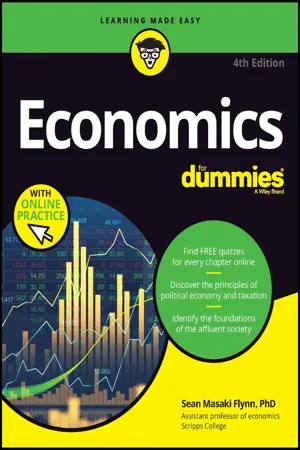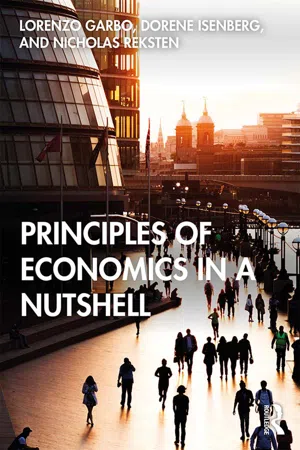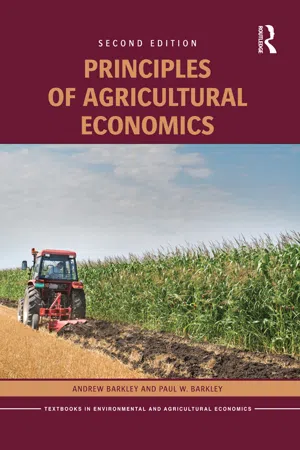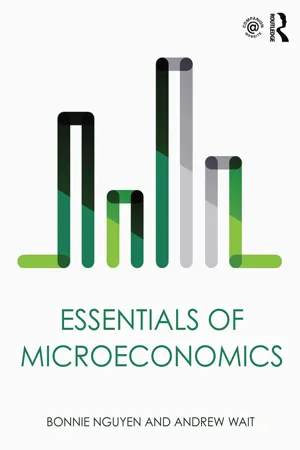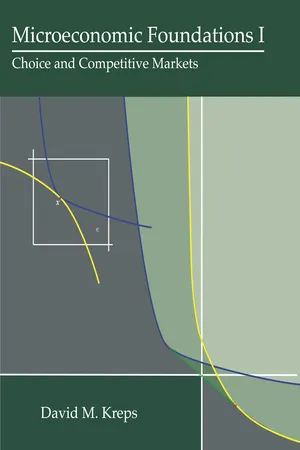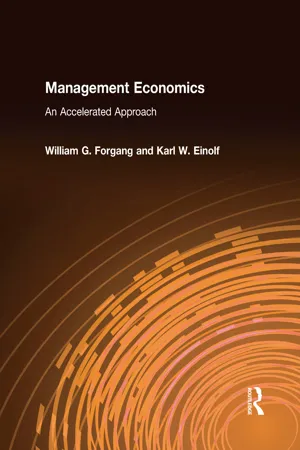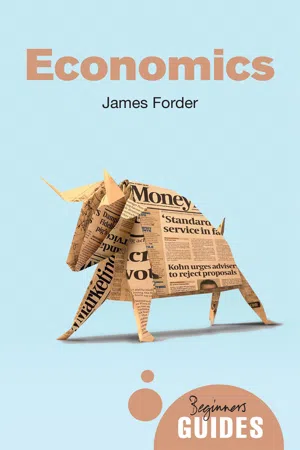Economics
Monopoly Profit Maximization
Monopoly profit maximization refers to the strategy employed by a monopolistic firm to determine the level of output that will yield the highest possible profit. This typically involves producing at the quantity where marginal revenue equals marginal cost. By setting prices higher than the marginal cost, monopolies can generate economic profits. This behavior is a key characteristic of monopolistic market structures.
Written by Perlego with AI-assistance
Related key terms
Related key terms
1 of 4
Related key terms
1 of 3
7 Key excerpts on "Monopoly Profit Maximization"
- eBook - ePub
Economics For Dummies
Book + Chapter Quizzes Online
- Sean Masaki Flynn(Author)
- 2023(Publication Date)
- For Dummies(Publisher)
H . At that output level, marginal costs are much bigger than marginal revenues, meaning that if you produce that unit of output, the cost of producing it will exceed the money you could get selling it. In other words, if you produce that unit, you’ll lose money.If you’re a monopolist, you want to produce exactlyqmunits because for all units up toqm ,marginal revenues exceed marginal costs, meaning that you receive more money selling such units than you spend producing them.Next, note that you can use the demand curve in Figure 8-2 to determine what price the monopolist will charge at output levelqm. That’s possible because, as we saw in Chapter 3 , demand curves indicate consumers’ maximum willingness to pay for any particular amount of output.In this case where the monopolist is going to want them to purchase the profit-maximizing output levelqm ,you can calculate the maximum price per unit that consumers would be willing to pay for that amount by starting out from output levelqmon the horizontal axis, going up vertically until you hit the demand curve, and then moving horizontally to the left until you hit the vertical axis. By doing so you can see that at output levelqm ,the monopolist can charge a maximum price ofpmper unit (which it will do because it has no competitors and thus no reason to charge anyone less than the maximum amount that they’re willing to pay).Eyeing the monopoly’s profit
A monopoly’s profit is the difference between total revenue and total costs. In Figure 8-2 , the profit that the monopolist makes is shown by the shaded rectangle with corners atA, pm , C,and B. As I discuss in Chapter 10 , such profit rectangles are derived by comparing the two rectangles that give, respectively, total revenues and total costs.The basic trick is to remember that the area of a rectangle is defined as a product — the product of its length times its width. Total revenue and total costs are also products — the price (or average cost) per unit multiplied by the number of units. Therefore, on a graph showing price along the y -axis and quantity along the x - eBook - ePub
- Lorenzo Garbo, Dorene Isenberg, Nicholas Reksten(Authors)
- 2020(Publication Date)
- Routledge(Publisher)
Draw a market and a single firm’s costs diagram next to each other, as done earlier in this section. Construct it so that the market is in its long-run equilibrium (the intersection of market demand and supply determines a price that is equal to the minimum AC). Profits, therefore, are zero for all the existing firms. Then, imagine that a successful social media campaign increases the market demand for the product. Show on your diagram the shift in the demand, the new equilibrium price, and what happens in the short-run to the existing firms.
A monopoly is literally the opposite market structure of perfect competition: only one firm produces the product, and no close substitutes of the product exist. How do monopolies come into being? Some of the reasons for which an industry may become a monopoly are:4.9Profit maximization in monopoly- Legal barriers to entry: no other firm can enter the market because of municipal laws (e.g., water), product or process patents, copyright, and so on.
- Economies of scale (a.k.a. increasing returns to scale): if the technology is such that the efficiency of the firm increases with its size, then the average cost must be decreasing all along. That is, the more a firm produces the lower its average cost is, and thus the lower the price the firm can charge. The largest firm can kick every other firm out of business!
- Exclusive ownership of essential resources for production (e.g., De Beers and diamonds in South Africa).
The big difference between monopoly and perfect competition is that the demand for the product of the monopolist is downward sloping rather than perfectly horizontal. In a monopoly, the firm alone faces the whole market demand of the product, and thus the price of the product completely depends on how many units of the product the firm brings to the market. This implies that the market price is under the complete control of the monopolist: we say that a monopolist is a price-maker - eBook - ePub
- Andrew Barkley, Paul W. Barkley(Authors)
- 2016(Publication Date)
- Routledge(Publisher)
4Profit maximizationPlate 4.1 Profit maximizationSynopsis
This chapter explores the profit-maximizing level of inputs and outputs for a firm in a competitive industry. It defines and explains perfect competition, and clarifies the economic approach of comparing benefits and costs in decision making. Graphs explain the optimal level of inputs and outputs. This chapter emphasizes the intuitive appeal of profit maximization and the rationale for using profits and losses to help determine a firm’s break-even and shutdown points. It is a comprehensive treatment of the heart of microeconomics.4.0 Introduction
The lessons regarding good economic decisions continue in this chapter. The materials presented here are important in economic decision making, and provide a comprehensive way of looking at the world. The “economic way of thinking” is based on comparing the benefits and costs of every human activity. It applies to purchasing a new pickup truck, attending college, or studying late. The Marginal Analysis used here is also an important tool of microeconomics that focuses attention on the advantages and disadvantages of each decision.- Marginal Analysis = comparing the benefits and costs of a decision incrementally, one unit at a time.
4.1 Perfect competition
To determine the profit-maximizing levels of inputs and outputs, we will use the concepts introduced in the preceding chapters and an additional piece of information, the price of the product (PY ). This price is the market price received by producers when they sell their output (Y). The units of the output price are in dollars per unit of output (USD/Y).The term “output price” requires additional assumptions (simplifications) about the structure of the market in which the firm operates. The assumptions simplify the analysis in order to make some important tools of economics into something easily learned and used in the quest for the profit-maximizing levels of inputs and outputs. The major simplification is that the firm under study is in an Industry characterized by Perfect Competition. - No longer available |Learn more
- Bonnie Nguyen, Andrew Wait(Authors)
- 2015(Publication Date)
- Routledge(Publisher)
m in the market. Because the demand equation determines the relationship between price and quantity, setting price to maximize profit yields the same outcome if the monopolist chooses the profit-maximizing level of output (that is, once either price or quantity is determined, the other variable is determined by the demand curve).13.4 Welfare under the single-price monopolist
In Chapter 9 , we found that welfare is maximized in a competitive market; the market equilibrium is where MB = MC – the equilibrium quantity traded will be where demand curve (the MB curve) intersects supply (the MC curve). The quantity traded at this point is called the ‘competitive quantity’, and is marked Q* in Figure 13.4 . By contrast, a monopolist trades up to the point where MR = MC, selling the ‘monopoly quantity’, and is marked Qm in Figure 13.4 . Note, as MB > MR for all units q > 0, this means that the monopolist sells less than the competitive market quantity Q*.Figure 13.4 The quantity traded in the market is lower under monopolist than in a competitive market13.4.1 Consumer and producer surplus
Let us begin by identifying consumer surplus under a monopoly. Recall from Chapter 9 that the size of consumer surplus is given by the area below the demand curve and above the price line for all units traded. In the case of a monopoly, we will need to use the monopoly price, Pm , rather than the competitive equilibrium price. The area that represents consumer surplus can be seen in Figure 13.5 .Figure 13.5 Consumer surplus and producer surplus under a monopolyLet us now turn to producer surplus. Recall from Chapter 9 that the size of producer surplus is given by the area above the marginal cost curve and below the price line for all units traded. Again, we will need to use the monopoly price, Pm . We will also need to remember that the quantity traded under a monopoly is Qm , so the untraded units beyond that point to not yield any surplus. Hence, the area of producer surplus will be truncated at Qm . The area that represents producer surplus can be seen in Figure 13.5 - eBook - ePub
Microeconomic Foundations I
Choice and Competitive Markets
- David M. Kreps(Author)
- 2012(Publication Date)
- Princeton University Press(Publisher)
It is impossible to do justice to this literature here, without expanding this chapter unreasonably and, in any case, some of the answers require pieces of economics that we haven’t yet studied. So I’ll plead simply that profit maximization is a modeling assumption, one with which economists are comfortable not as a law of nature but as an approximation to reality. Having said that, three specific points are worth making, albeit briefly. • Profit maximization as an objective function for firms is a lot more specific than utility maximization for consumers. When we assume that a consumer maximizes her utility, we leave it up to the consumer how she feels about apples versus oranges. But, once prices are given, the trade-offs facing a firm are fixed if the firm maximizes profit. (On the other hand, the choice set of a consumer is fixed once prices are fixed and the consumer’s income is given. For firms, the production-possibility set Z gives a lot of latitude to the modeler.) • Accounting earnings or income is not economic profit. Accounting income does not include any return on capital equipment. • The arguments in the literature for profit maximization when there is a division between managers and owners of the firm turn to some extent on a contention that managers act on behalf of the firm’s owners, who prefer profit maximization. Why managers do this is usually the issue being studied in the literature. But it is worth noting that the assertion that owners prefer profit maximization is very bound up in the assumption that the firm has no impact on prices - eBook - ePub
Management Economics: An Accelerated Approach
An Accelerated Approach
- William G. Forgang, Karl W. Einolf(Authors)
- 2015(Publication Date)
- Routledge(Publisher)
This chapter described the microeconomic environments in which firms operate. The process by which managers make decisions—including how to determine price, calculate production needs, and implement a marketing plan—depends heavily on the microeconomic structure of the industry. Each of the four market structures—monopoly, oligopoly, monopolistic competition, and perfect competition—were described to help managers understand how dependent they are on these economic environments. To maximize profit, increase market share, and effectively compete, managers must understand their firm’s strategic position in its industry.Review TermsAverage cost pricing Monopolistic competition Best response Monopoly Coordination game Nash equilibrium Cost-efficient Natural monopoly Dominant strategy Oligopoly Game theory Perfect competition Marginal cost Prisoner's dilemma Marginal profit Product differentiation Marginal revenue Revenue and profit sharing Minimax technique Discussion Questions1. A spreadsheet software package such as Microsoft Excel can be used to quickly determine a monopolist’s profit-maximizing price and quantity. Figure 6.9 shows an Excel spreadsheet using the demand function in Table 6.2 and the cost function in Table 6.4 . The spreadsheet calculates the quantity demanded, revenue, cost, and profit for any price that is entered into cell B2. A price of $34 is entered into cell B2 as an example. The functions used in each of the cells are displayed in Table 6.19 .Figure 6.9 Excel SpreadsheetTable 6.19 Excel Functions in Figure 6.9Cell Function A2 = 20 − 0.5*B2 B2 = 34 C2 = A2*B2 D2 = 26 + 12*A2 E2 = C2 − D2 Microsoft Excel has a Solver tool that searches for the price that maximizes the firm’s profit. The Solver is under the “Tools” menu on the Excel menu. (If the Solver option does not immediately appear, select Tools/Add-ins and bring the Solver tool into the computer’s memory.) The Solver dialogue box is displayed in Figure 6.10 . The target cell, E2, isging cell B2. When the Solve button is selected, Excel will find the price that maximizes the firm’s profit. The results are shown in Figure 6.11 .Figure 6.10 Excel Solver Dialogue Box - eBook - ePub
Economics
A Beginner's Guide
- James Forder(Author)
- 2016(Publication Date)
- Oneworld Publications(Publisher)
diagram 7 . That shows the price times the quantity, which is total revenue, minus the average cost times the quantity, which of course is total cost. So it shows total revenue minus total cost, which is profit.Diagram 7 ProfitThere is, of course, nothing forcing the firm to maximize profit (unless the maximum profit achievable is zero). Alternatives might be a careless attitude to customer relations or lax cost control, for example. Simply ignoring the phone is an alternative to maximizing profit, as is appointing incompetent family members to senior positions. Or, for that matter, engaging in activities exhibiting ‘corporate social responsibility’ may reduce profit, but nevertheless be thought desirable.So far so good. That is an economic model. It is not a refined model, and it has plenty of clear limitations and various little gaps in the logic. Never mind. As with the earlier discussion of the used-car market, the question is whether the model provides useful insight and, as usual, the best thing is to carry on and find out.Amongst the insights arising from considering this model, first of all there is the point that profit maximization arises where marginal cost is the same as marginal revenue. That point is much more general than the model, of course, and comes up, with slight variations, again and again in economics. Another point is that profit-maximizing price is always higher than marginal cost. In diagram 6 that is apparent from the fact that the demand curve is always above the marginal revenue curve. The quantity to be sold is determined by the intersection of MC and MR – that is, q1 in diagram 6 . But there, marginal cost is c1 , so quantity is q1 and the price at which that quantity can be sold is p1 . That is important because it has the unfortunate consequence that there are consumers who would be willing to pay a price which is greater than the marginal cost of production – c1 – but less than p1 who end up not buying the product. In that sense there is a way in which the system has failed – both the consumer and the producer could be made better off if there were extra production up to q2
Index pages curate the most relevant extracts from our library of academic textbooks. They’ve been created using an in-house natural language model (NLM), each adding context and meaning to key research topics.
Explore more topic indexes
Explore more topic indexes
1 of 6
Explore more topic indexes
1 of 4
